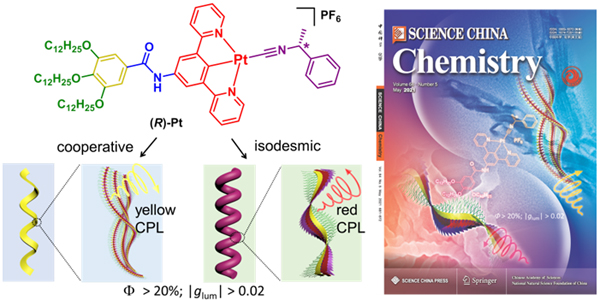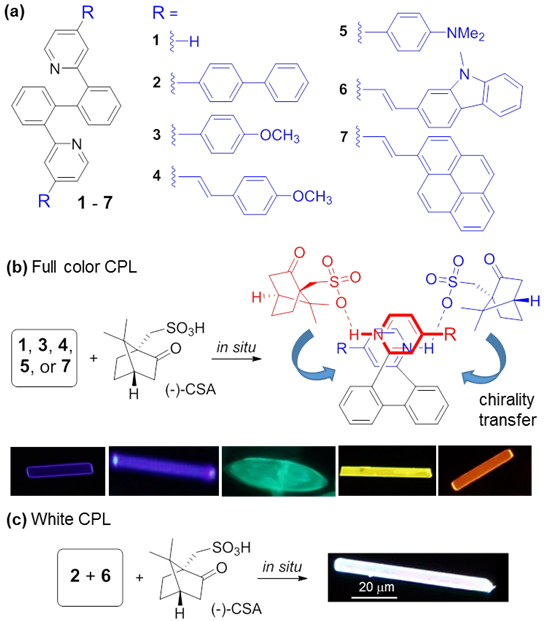Location: Home > Research News
Research News
Researchers prepare organic micro- and nanostructures with Full‐Color and White Circularly Polarized Luminescence
Chiral functional micro/nano materials with circularly polarized luminescence (CPL) have drawn intense attention in the past decade due to their potential applications in photoelectric devices, optical sensors, and asymmetric catalysis, etc. The research team led by Prof. Yu-Wu Zhong at Institute of Chemistry, Chinese Academy of Sciences (ICCAS) has recently prepared a series of organic micro- and nanostructures showing full‐color and white CPL.
A pair of enantiomeric platinum complexes decorated with a chiral α-methylbenzyl isocyanide ligand are designed and prepared. By using the mixed-solvent (THF/n-hexane) or high-concentration condition, these complexes are able to assemble via a cooperative or isodesmic pathway with significantly-enhanced yellow or red emission, respectively. As a result, helical nanoribbons and nanofibers with an opposite handedness are obtained from the complex with the same molecular chirality to show efficient CPL with a luminescence dissymmetry factor |glum| of over 0.02 and emission quantum yield Φ over 20%. This study entitled “Handedness-Inverted Polymorphic Helical Assembly and Circularly Polarized Luminescence of Chiral Platinum Complexes” was recently published in Science China Chemistry (doi: 10.1007/s11426-020-9911-4).


This work was financially supported by National Natural Science Foundation of China and Chinese Academy of Sciences.
Institute of Chemistry, Chinese Academy of Sciences
Email: zhongyuwu@iccas.ac.cn
A pair of enantiomeric platinum complexes decorated with a chiral α-methylbenzyl isocyanide ligand are designed and prepared. By using the mixed-solvent (THF/n-hexane) or high-concentration condition, these complexes are able to assemble via a cooperative or isodesmic pathway with significantly-enhanced yellow or red emission, respectively. As a result, helical nanoribbons and nanofibers with an opposite handedness are obtained from the complex with the same molecular chirality to show efficient CPL with a luminescence dissymmetry factor |glum| of over 0.02 and emission quantum yield Φ over 20%. This study entitled “Handedness-Inverted Polymorphic Helical Assembly and Circularly Polarized Luminescence of Chiral Platinum Complexes” was recently published in Science China Chemistry (doi: 10.1007/s11426-020-9911-4).

Handedness-inverted assembly and CPL (Image by Prof. ZHONG Yu-Wu)
In addition, these researchers have developed a simple and general method to prepare CPL-active microcrystals with large |glum| and Φ, wide emission color tenability, and well-ordered morphology. The reactions of the pyridine-containing achiral molecules 1--7 with chiral camphor sulfonic acid ((±)-CSA) are found to give crystalline microplates showing hydrogen bonding interactions between the protonated pyridinium units and the sulfonic anions. The chiral information of CSA are effectively transferred to the microcrystals by hydrogen bonding to afford full-color CPL from deep-blue to red with |glum| in the order of 10-2 and Φ up to 80%. Moreover, organic microcrystals with high-performance white CPL (Φ = 46%; |glum|= 0.025) are achieved via the light-harvesting energy transfer between blue and yellow emitters. These materials hold great potential for applications nanophotonic devices. This work entitled “Full‐Color and White Circularly Polarized Luminescence of Hydrogen‐Bonded Ionic Organic Microcrystals” was recently published in Angew. Chem. Int. Ed. (DOI: 10.1002/anie.202103091). 
The preparations of microcrystals with full-color and white CPL (Image by Prof. ZHONG Yu-Wu)
This work was financially supported by National Natural Science Foundation of China and Chinese Academy of Sciences.
Contact:
Prof. ZHONG Yu-Wu Institute of Chemistry, Chinese Academy of Sciences
Email: zhongyuwu@iccas.ac.cn





